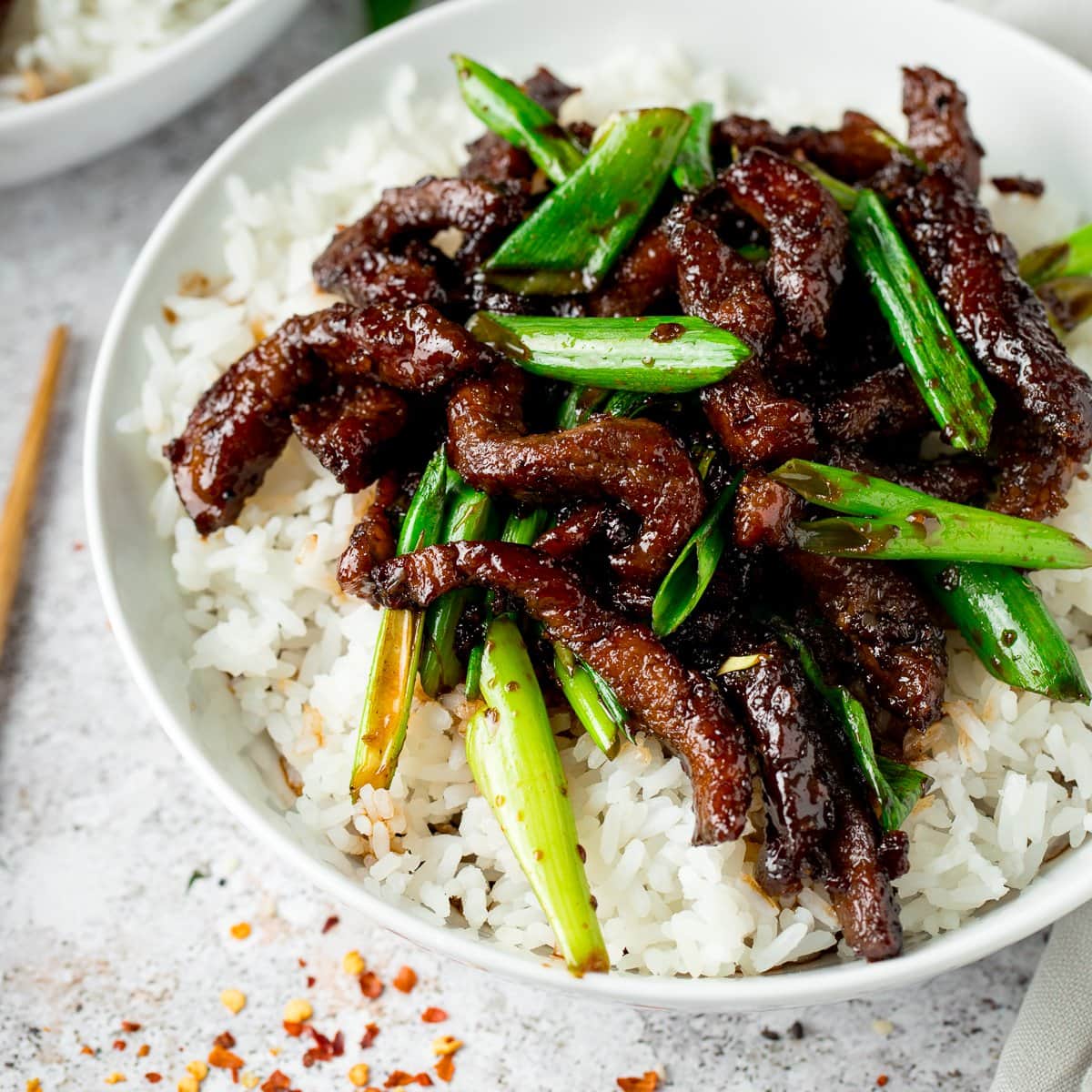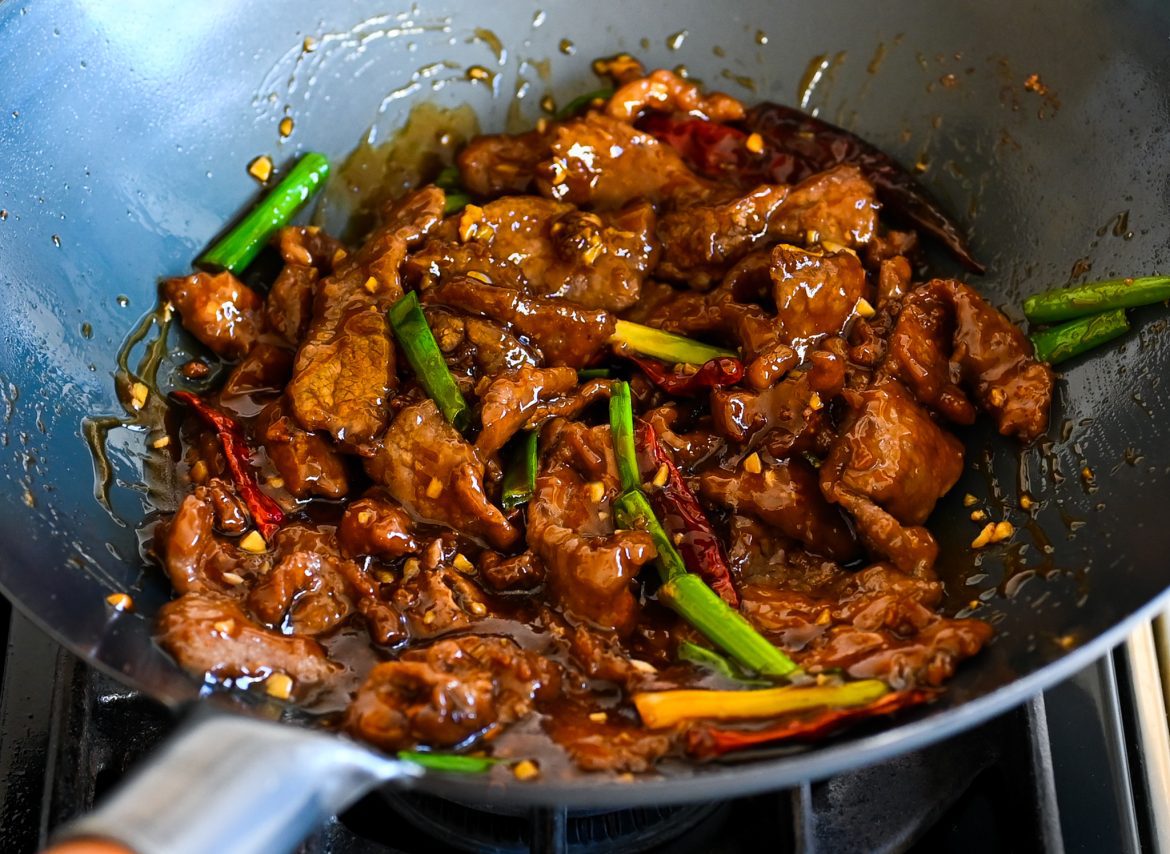You’re about to uncover the secrets of Mongolian Beef, a Chinese-American dish that masterfully balances flavors. This crispy and flavorful stir-fry is made with beef and a soy sauce glaze, combining the richness of soy sauce, oyster sauce, and hoisin sauce. With a strong background in Cantonese and American Chinese cuisine, our expertise guarantees a traditional and authentic recipe. From marinating beef strips to creating a savory glaze, we’ll guide you through the cooking process. With each step, you’ll get closer to creating a dish that’s both crispy and flavorful. Now, discover the perfect harmony of flavors that’ll leave you wanting more.
Key Takeaways
- This Chinese-American dish, Mongolian Beef, is a cultural fusion of flavors, not a traditional Mongolian cuisine.
- Marinate beef strips in soy sauce, cornstarch, and vegetable oil for a crispy texture, then cook until golden brown.
- A Soy Sauce Glaze made with soy sauce, oyster sauce, hoisin sauce, and sugar adds depth to the dish.
- Serve the crispy beef over steamed rice to balance the savory sauce, and garnish with green onions and sesame seeds for freshness.
- Quick-searing the beef in small batches on high heat achieves a crispy exterior, while a balanced sweetness and acidity create a savory flavor profile.
Origins of Mongolian Beef
The Real Story Behind Mongolian Beef
Mongolian Beef, a popular Chinese-American dish, doesn’t actually come from traditional Mongolian cuisine. In fact, Mongolian cuisine typically involves boiled meat dipped in sauces, which is quite different from the sweet and savory flavors we’re familiar with.
A Mix-Up in Names
The name ‘Mongolian Beef’ is likely a result of a mix-up with ‘Orange Beef,’ another Chinese-American dish. Chinese-American menu planners probably coined the name to make it sound more exotic.
A Cultural Fusion
Historically, Mongolian Beef has no roots in traditional Mongolian cuisine. Instead, it’s a cultural fusion of Chinese and American flavors. The dish has undergone significant variations, adapting to local tastes and ingredients.
What to Expect
When you order Mongolian Beef, you’ll usually get it served with steamed rice, a staple in Chinese cuisine. Despite its misconceptions, Mongolian Beef has become a beloved dish in its own right, with its sweet and savory flavors winning over palates worldwide.
Understanding Chinese-American Cuisine
As you explore the world of Chinese-American cuisine, it’s essential to understand the cultural influences and historical origins that shape the dishes we love today.

Recipe Adjustments and Updates
Recipe Adjustments and Updates
Traditional Mongolian Beef recipes can be too sweet and lacking in flavor. To fix this, we made some changes to create a more balanced and flavorful dish.
Balancing Sweetness and Flavor
- We added more umami flavors like soy sauce and oyster sauce to balance out the sweetness.
- We replaced water with beef broth to add more depth to the dish.
Cooking Variations
- We quick-seared the beef to make it crispy.
Presentation Ideas
- Garnish with green onions and sesame seeds to add color and freshness.
- Serve with steamed rice to soak up the savory sauce.
These adjustments resulted in a more complex and satisfying Mongolian Beef recipe that will elevate your Chinese-American cooking skills.
Culinary Background and Expertise
My Culinary Background and Expertise
I have a strong background in cooking that started from humble beginnings. I used to assemble sandwiches at Burger King, and later, I cooked at my family’s Chinese restaurant. This diverse experience taught me a lot about traditional Cantonese and American Chinese cuisine.
My Culinary Journey
My culinary journey has taken me from learning the basics of Cantonese cooking to mastering American Chinese takeout dishes. I’m skilled at balancing flavors and textures to create authentic and delicious dishes.
Culinary Highlights:
- I developed a passion for traditional Cantonese cuisine by working at my family’s Chinese restaurant.
- I mastered the art of cooking various Chinese-American dishes, including Mongolian Beef.
- I acquired expertise in traditional Cantonese flavors and cooking techniques.
- I create recipes that showcase my understanding of Chinese culinary traditions.
- I continuously refine my skills to provide the best culinary experience for my audience.
Mongolian Beef Recipe Details
Mongolian Beef Recipe
To make this popular Chinese-American dish, you need to marinate thinly sliced beef strips in a mixture of soy sauce, cornstarch, and vegetable oil for at least 30 minutes. This step is crucial in creating the signature crispy exterior and flavorful interior of Mongolian Beef.
Marinating and Cooking the Beef
Marinate the beef strips in a mixture of soy sauce, cornstarch, and vegetable oil for at least 30 minutes.
Cook the beef strips in a wok or large skillet with some oil until they’re crispy and golden brown.
Set the beef aside.
Making the Soy Sauce Glaze
Whisk together soy sauce, oyster sauce, hoisin sauce, and sugar in a small bowl to make the Soy Sauce Glaze.
Final Steps
In the same wok or skillet, add more oil if needed, then pour in the Soy Sauce Glaze and bring it to a simmer.
Once the glaze has thickened, add the cooked beef back into the wok or skillet and toss everything together until the beef is well coated.
Serve immediately over steamed rice to complete this mouth-watering Mongolian Beef dish. Enjoy with a refreshing Cucumber Salad to balance the savory richness of the beef.

Cooking Techniques and Tips
Mastering Mongolian Beef: Essential Cooking Techniques
To make a delicious Mongolian Beef dish, you need to master some key cooking techniques. Let’s explore these techniques to achieve the perfect balance of crispy exterior and flavorful interior.
Why Marinating Matters
Marinate the beef for at least 30 minutes to let the flavors sink in. This step is crucial to making your dish tasty.
Stir-Fry Secrets
Use high heat and quick movements to stir-fry the beef. This will give you the signature crispy exterior.
Searing Tips
Sear the beef in small batches to prevent overcrowding and ensure even cooking.
Balancing Flavors
Balance the sweetness of the soy sauce glaze with a hint of acidity from the vinegar. This will create a rich and savory flavor profile.
Temperature Control
Maintain a consistent wok temperature to prevent the glaze from burning or the beef from overcooking.
Nutritional Information and Serving
Nutritional Information and Serving
Understanding the Calories in Mongolian Beef
Mongolian Beef packs 383kcal, 26g of protein, and 16g of fat per serving. This calorie count is relatively moderate, making it a suitable option for those watching their diet.
Portion Control is Key
When it comes to portion control, it’s vital to be mindful of the serving size to maintain a balanced diet. Here are some key points to remember:
- A standard serving of Mongolian Beef is approximately 300g, which is roughly the size of your palm.
- Be aware of your hunger cues and adjust the portion size accordingly to avoid overeating.
Putting the Nutritional Information into Perspective
Here are some key facts to consider:
- The daily recommended intake of protein is about 50g, and the 26g in this dish accounts for roughly half of that.
- The fat content is relatively high, but it’s mainly due to the soy sauce glaze, which adds flavor and moisture to the beef.
Alternative Recipes and Comparisons
Discover Alternative Recipes to Mongolian Beef
Want to try something new? Exploring alternative recipes can broaden your culinary horizons. Mongolian Beef has some fascinating variations and similarities with other Chinese-inspired dishes.
Mongolian Chicken: A Popular Alternative
Try Mongolian Chicken, a popular alternative that substitutes chicken breast for beef. This dish is easy to make and tastes great!
Similar Recipes to Mongolian Beef
- Singapore Noodles: This dish shares similarities with Mongolian Beef in marinating meat, coating with cornstarch, and searing until crispy.
- Kung Pao Chicken: Another spicy Sichuan-inspired dish that pairs well with steamed rice.
- Beef and Broccoli: A classic Chinese-American dish that combines beef with steamed broccoli and soy sauce.
- Crispy Orange Beef: A variation that uses orange marmalade for a sweet and sour glaze.
Why Try Alternative Recipes?
These alternatives offer unique flavor profiles and cooking techniques that can enhance your culinary skills. By exploring these recipes, you can develop a deeper understanding of Chinese-American cuisine and expand your cooking repertoire.
Interacting With the Recipe Community
Share Your Mongolian Beef Recipe and Learn from Others
When you’ve perfected your Mongolian Beef recipe, share your experiences with the recipe community. This helps you refine your cooking skills and discover new recipe variations.
Benefits of Community Engagement
- Inspire Others: Share your unique recipe variations and inspire others to try new things.
- Learn from Others: Read and respond to comments to learn from others and share your expertise.
- Refine Your Skills: Participate in recipe discussions to refine your cooking skills and gain new ideas.
- Help Others: Share your cooking experiences to help others avoid common mistakes.
- Discover New Flavors: Experiment with new ingredients to discover unique flavor combinations.
